|
Kazanın
başında elindeki sopayla var gücüyle karıştırıyordu ipleri.
Terini sildi elinin tersiyle. Eşine seslendi: Bir kova daha su;
birazcık da ceviz kabuğu.... Bir saatlik uğraşın sonunda
kan-ter içinde kaldı. Çay molası zamanı dedi;
|
|
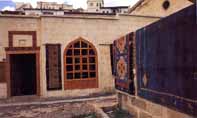
|
|
işini bırakıp
mutfağa geçti. Çaylar içildi; esprili söyleşiler eşliğinde...
Başka bir işi daha vardı: Okul Aile Birliği toplantısı var
da.... İş giysilerini bir yana bırakıp. modern giysileriyle
minibüsün direksiyonuna geçip gözden kayboldu. Arkadan eşine
Bir saat sonra gelirim dediği duyuldu belli belirsiz. Okul
Aile Birliğindeki sorumluluğunu yerine getirip döndü Songül
Tokmak; beş dakika sonra iş giysileriyle kaldığı yerden tekrar
işe koyuldu; eşine seslendi: Nerede kalmıştık? Songül ve
Ömer Tokmak, iş yerinin hem işçisi hem de patronuydular. Üstelik
inatla dededen-nineden öğrendikleri doğal bitkilerle yünleri
boyayıp, yöredeki tezgahlarda halı dokutuyorlardı. Ömer Tokmak
da adeta işine aşıktı. Doğadan özenle topladığı bitkileri
ayrı ayrı çuvallara doldurmuş, sırası geldiğinde onları
istediği renklere dönüştürüyor, ipleri boyayıp kuruması için
duvarlara asıyordu.
|
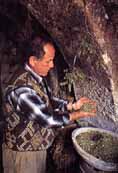 |
İşyeri
olarak kullandıkları mekan eski bir Avanos evi. Geniş bir avlusu
var. Boyama yapılan yer avlunun bitişiğinde. Köylerden toplanan
yünler burada çıkrıklarda eğirilip, bitki kökleri, yaprakları
veya kabuklarıyla boyanıp, kurutulup çileler haline
|
|
getiriliyor.
Aile dışında tek yardımcıları yaşı yetmişi bulmuş komşuları;
komşu teyzeleri hem eğirme işini yapıyor hem de boyanmış-kurumuş
ipleri çile halıne getiriyor. Avlunun kuzey bölümünde başka
bir kadın, yılların eskitemediği bir tezgahta halı dokuyor.
Bu
eski Avanos evi bir halı fabrikası değildi ama bir fabrika gibi
de çalışıyor: Turistlere el emeği, alın teri, göz nuru halılarımızın
geleneksel yöntemlerle yapılışını, tüm aşamalarını burada
sergiliyoruz; bir de acı kahvemizi içiyorlar bu avluda... diyor
Ömer Tokmak. Adeta bir aile şirketi gibi çalışıyor
Tokmak ailesi; çocukları da destek veriyor ana babalarına. Kimi
zaman ipleri boyayarak, kimi zaman da yabancı turistlere tercümanlık
yaparak... Ve ekliyor Ömer Tokmak: Avanosta 30 yaşına gelmiş
bir insana sorun; kadınsa halı dokur, erkekse çamurdan çanak,
çömlek yapar...
|
|
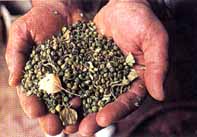
|
|
Bu
iş uzaktan göründüğü kadar kolay mıydı? Derelerden,
tepelerden bitkileri toplamak ve kendi doğal rengi dışında yün
ipleri allı-morlu renklere dönüştürmek... Bir sırrı var mıydı
bu işin? En büyük sırrı sevgi. İnsan sevdiği işte başarılı
oluyor. Yurtdışı çalışma yaşamlarının tamamlanması,
Avanosa dönmeleri... Ve dede-nine işine soyunmaları... Bu evi
restore etmeleri... Tokmak ailesinin öyküsü burada bitmiyor:
Burası bizim hem işyerimiz hem de evimiz gibi. Tüm üretim aşamalarında
biz varız. İşimizi alın terimizle yoğuruyoruz. Bitkileri
mevsiminde toplamak gerekiyor. Ceviz kabuğu, cehri, yapışkan ot,
meyan kökü, ennig (hava cıva otu)... Bunlar mevsiminde, zamanında
toplanıp kurutulmalıdır. Boyama sırasında belirli derecede ısıtılmış
suda bu bitkilerin karışımıyla iplik
kaynatılıp, sonra
da
|
|
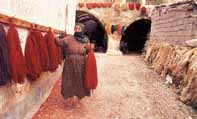
|
|
durulanmalıdır. Ardından kurutulması, çilelere ayrılması. Sağ
olsun komşularımız da bize destek veriyorlar üretim aşamalarında.
Sonra da asırlık tezgahlarda dokunması... Kahverengi ceviz
kabuğundan, sarı cehriden, kırmızı yapışkan otu ve meyan kökünden
elde ediliyor. Ham yünler su dolu kazanlarda şap ile karıştırılıp
kaynama noktasına getirilip bekletiliyor, sonra da istenilen
bitkilerden istenilen renkler elde ediliyor. Ara tonlarda da zorlanmıyor
usta eller: Meyan kökü ve cehri karışımından portakal
rengini; hava cıva otundan gri ve moru; cehri sarısı ve toz
indigodan ise yeşil rengi elde ediyoruz... Ya siyah?
Siyah yünün kendi doğal rengidir; siyah renkte boyama yapmıyoruz.
Kaliteli halının, başka bir deyimle değerli halının tanımını
soruyoruz Ömer Tokmaka: Kaliteli bir halı için iyi bir yün
gerekli; esnek, kolay kırılmayan, yeterli yağ oranı olan, aşırı
kalın ya da ince olmayan ve boya tutma özelliği olan bir yün...
Doğal ortamında yıkanmalı; fazla hırpalanmadan didilmeli; sonra
da eşit kalınlıkta -elde ya da çıkrıkta- eğirilmeli...
Dokumasını da usta eller yaptıysa ortaya değerli dokuma halı çıkıyor.
|
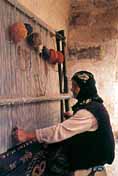 |
Bu
sefer direksiyonun başına Ömer Tokmak geçiyor ve düşüyoruz
yollara; bu renkleri oluşturan bitkileri toplayacağız. Önce
kendi bahçelerinden cehri (meyvelerini) topluyoruz, sonra
da derelerden tepelerden hava cıva otu...
|
|
Yolumuzun üzerindeki Sarıhanda
soluklanıp Bozca Köyüne geçiyoruz. Önce çocuklar takılıyor
minibüsün peşine; Halıcı geldi... diye. Sonra da köydeki
yaşlılar ve halı dokuyan kadınlarla, kızlarla tanışıyoruz.
92 tane halı tezgahı olan Bozca Köyünde -son yıllarda verdiği
göçle- 14 halı tezgahı kalmış. Bozcanın evleri yöreye özgü
kesme taş işçiliğinin en güzel örnekleri; yörenin coğrafyasına
ve iklimine uygun yapılmış. Bir dokumacının evindeyiz; ikram
edilen acı kahveyi içmeden ayrılmak olur mu? Yeni boyanmış
ip istiyor dokumacılar ve ekliyorlar Yünler bizden; ipler halıcıdan...
Sonra da bitmiş halılar arabaya yükleniyor birer birer; binlerce,
on binlerce ilmik atılarak dokunmuş halılara biraz hüzün ama işi
tamamlamanın mutluluğu ile son kez bakıyorlar.
Ya
desenler? Sevgiyle yoğrulan desenler?.. Bazen yörenin hazır
desenlerini veriyoruz halı dokuyanlara; Arabeli, Çubuk Suyu,
Leblebili, Eli Belinde... Ya doğaçlama dokuyanlar? Genç kızlarımız
oldukça çabuk kavrıyorlar; bizim desenlerimize kendi yaratıcılıklarını
da eklediklerinde özgün desenler çıkıyor ortaya...
Ya desenlerin dili?
Biz halı dokuyacak |
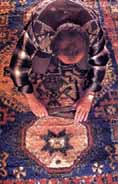
|
olanların
desenlerini az çok önceden tahmin edebiliyoruz; hangi evden nasıl
bir halı çıkar... Desenlerden o anki ruh halleri ortaya çıkıyor;
sevinçli, hüzünlü, coşkulu anlar... Acılar da gizli bu
desenlerde... Sevgi ve özlemler de...
|
|
|
|
|
|
She
stood over the great cauldron stirring the yarn energetically. Then
she wiped the perspiration from her forehead with the back of her
hand and called to her husband, Another bucket of water, and some
more walnut shell. It was tiring work and she had been at it for
an hour. Time for a tea break she declared, and leaving the
cauldron went into the kitchen, where we sat drinking tea and
chatting cheerfully. Then she had another job to do; attending a
parents meeting at the school. Having changed her working clothes
for an elegant modern outfit, she got behind the wheel of the
minibus and disappeared down the road, calling out to her husband
that she would be back in an hour. On her return from the parents
meeting, Songül Tokmak changed back into her working clothes.
Now where were we? She asked her husband.
|
|
Songül
Tokmak is her husbands main assistant in the business which they
both own and work for. They resolutely continue to dye wool with the
natural dyes that they learnt to make from their grandparents. This
wool is then used for the carpets which
they |
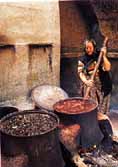
|
|
commission from
local
weavers. Ömer Tokmak is passionately devoted to his work. He
gathers the roots, leaves and bark used for dyes himself and stores
them in sacks. When dyed the wool is hung up on the walls to dry.
Their
workplace is an old house in Avanos, in Cappadocia. It has a large
courtyard, off which is the area where they do the dyeing. Raw wool
supplied by neighboring villages is spun on spinning wheels, and
after dyeing wound into hanks. Their only assistants who are not
members of the family are two neighbors both in their seventies, one
of whom does the spinning and winding of the wool into hanks and
another woman who weaves carpets on an ancient loom in the northern
part of the courtyard.
|
|
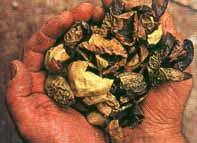
|
|
This
old Avanos house is always bustling with activity. Not only is there
the regular work of dyeing, spinning and organizing the carpet
weaving, but they also welcome tourists who come to see how the
carpets are made, and demonstrate all the different stages of the
laborious traditional methods. And every visitor is offered a cup of
Turkish coffee in the courtyard, Ömer Tokmak tells us. The
Tokmak familys children help their parents too, sometimes by
dyeing the wool, and sometimes by acting as interpreters for foreign
visitors. Carpet weaving and pottery are the traditional crafts of
Avanos, and Ömer Tokmak says that if I were to ask anyone over the
age of 30 in Avanos about their occupation, the women would be
certain to answer that they wove carpets, and the men that they were
potters.
|
|
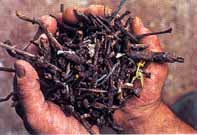
|
|
Was
it as easy as it seemed, I wondered, to gather wild plants and dye
the wool in the desired colors? Was there a secret to it? The
greatest secret is love, he replied. Success lies in loving
ones work. After working abroad for many years, Ömer and Songül
Tokmak returned to Avanos to take up the occupation of their
ancestors in a house which they restored themselves. This is both
our workplace and a second home. Usually my wife, the children and I
only get back to our house late at night. We are involved in all the
stages of production and work hard. The plants have to be gathered
in the right season. Dyes are made from walnut shells, the
berries of a species of buckthorn (Rhamnus petiolaris), pellitory
(Parietaria officinalis), liquorice root oriental alkanet (Alkanna
tinctoria) and many others. These are dried, and boiled in water in
various combinations to produce the desired colors.
|
|
The
raw wool is first boiled in water containing alum and then left to
soak before dyeing. When the wool has been dyed, it is rinsed and
dried. Then the wool is used for weaving carpets on traditional old
looms. Walnut shells produce the
|
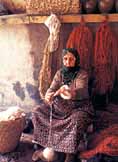
|
|
color brown, buckthorn yellow, and
pellitory and liquorice root red, for example. Mixtures of the
different dye materials produce other colors, such as orange from a
mixture of liquorice root and buckthorn, and green from a mixture of
buckthorn and indigo powder. And what about black? For that we
use natural black wool not dye explains Ömer Tokmak.
We
asked him what qualities to look for in a carpet. He told us that a
good quality carpet must be made of good quality wool, pliant and
strong, containing sufficient oil, neither too thick not too thin,
and able to take the dye well. The raw wool must be washed by hand,
combed without treating it roughly, and then spun, either by hand or
using a spinning wheel. If it is then woven into a carpet by a
skilful weaver the result is a high quality carpet.
Then
we set out with Ömer Tokmak at the wheel on an expedition to gather
wild plants. We stopped first at his own garden to gather buckthorn
berries, and then headed out into the countryside to find oriental
alkanet. After a halt at Sarihan we went on to the village of Bozca.
Children pursued the minibus shouting, The carpet mans
here! We were met by the elderly people, and the women and girls
who weave carpets. There were once 92
looms in the
|
|
village, but as
many of the inhabitants have moved away to the cities, today only 14
carpet looms remain in use. The houses of Bozca are beautiful
examples of the excellent local stonework, appropriate to an area
lacking in forests and with a harsh continental climate.
|
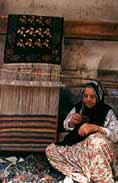
|
|
In
the home of one of the weavers we were offered the usual cup of
coffee. The weavers asked for more dyed yarn, and explained that
they supply the raw wool which is returned to them as dyed yarn.
Finally the finished carpets were loaded into the van, and the women
looked for the last time with mingled regret and pride at the
carpets whose tens of thousands of knots they had woven with loving
care.
And
what about the designs? Sometimes we provide ready made patterns
for motifs from carpets of certain regions, such as the Arabeli, Çubuk
Suyu, Leblebili, and Eli Belinde motifs. And do any of them weave
without a pattern? Our young girls are quick to learn. When they
add their own inspiration to our designs, they produce original
pieces. We have got to know more or less what each weaver is likely
to produce. The designs are also influenced by their mood at the
time; whether they are happy, excited or sad. Sorrows are concealed
in the designs as well as love and yearning.
|
|